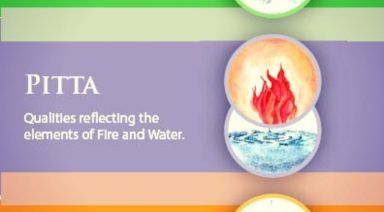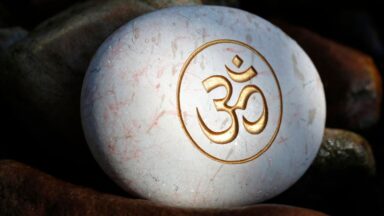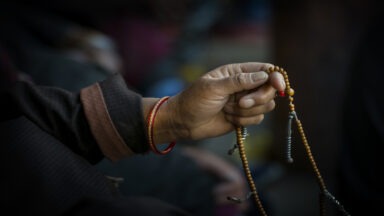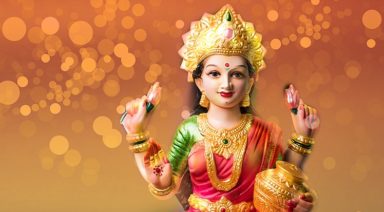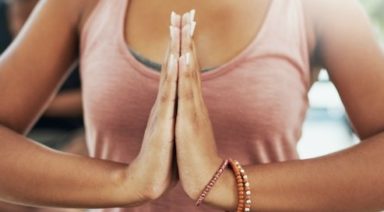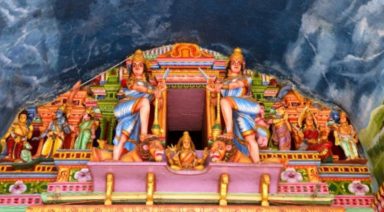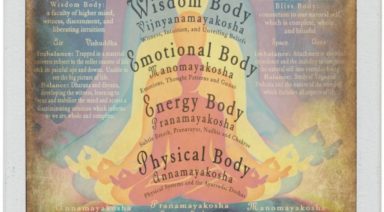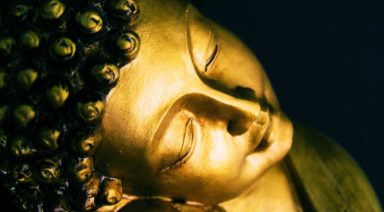How Your Emotional State Relates to the Ayurvedic Doshas

Ayurveda is the science of life. It is a holistic form of wellness that uses natural, earth-based wisdom to promote individual balance and health. Ayurveda teaches that there are three universal intelligences at work in the macrocosm of the universe and in the microcosm of our bodies. These intelligences are called the doshas. The doshas are made up of a combination of the five great elements: earth, water, fire, air, and ether. These five elements tend to group together into pairs that create the doshas: Vata, Pitta, and Kapha.
Vata
Vata is likened to the combination of air and ether; it is light, dry, cold, and changeable. It rules everything in the body and the universe that has to do with movement, transportation, and communication. Our speech, for example, is ruled by Vata dosha as is the motion of our intestines during peristalsis.
Pitta
Pitta is the combination of the fire element with a bit of moisture. It is the intelligence that governs everything that transforms, digests, and metabolizes. It governs all that transforms in our bodies; the enzymatic action of the stomach, the power of our sight, and our metabolism are some of the areas of the body ruled by Pitta dosha.
Kapha
Kapha dosha is likened to earth and water. It is heavy, cool, and stable. It rules our immunity, our strength, and our stability. Kapha dosha also rules the watery places in the body, the lining of the stomach, and the inside of the mouth, as well as our overall strength and immune system.
Understanding Your Emotional Ama
The doshas, however, do not just impact your physical body. The doshas are intelligences that rule all aspects of your mind, body, and emotions. In this way, you can see that your emotional states are likewise determined by the doshas. You can describe, analyze, and witness your emotional states in terms of the doshas.
This process allows you to process and digest your emotions. Ayurveda teaches that the result of anything undigested is ama, a thick toxic sludge that clogs up your vital channels. Just as food can remain undigested in the gut and cause ama, undigested, unprocessed emotions can also cause emotional ama. The result of this ama is repressed anger, sorrow, depression, and anxiety. The wisdom of Ayurveda can provide you with the keys to understand your emotions.
You can think of the qualities of the doshas as having balanced and unbalanced characteristics. Vata, when in balance in the body, will result in great elimination. When it is out of balance, however, you may experience a loose stool or constipation. Similarly, you can understand the emotional aspects of the doshas as having qualities that are in and out of balance.
Your Emotions & Vata Dosha
When in balance, Vata dosha will express itself as balanced enthusiasm and energy. The expression will be clear-minded, quick-witted, and supportive. When out of balance, Vata dosha will express itself emotionally as anxiety, fear, or being overwhelmed. You may become “spaced out,” flighty, indecisive, unaware, or unfocused. This is because your mind and emotions are experiencing the negative qualities of space and ether; too unfocused and spacey.
Solving for Vata
Vata dosha needs nurturing. You can calm your anxiety with awareness and meditation. If experiencing Vata emotions, you should ensure you are getting adequate rest. You can also perform a daily self-massage with warm sesame oil. Because Vata is irregular in nature, you can tame Vata by establishing a regular routine and sticking to it.
Eating warm, well-cooked, and slightly rich homemade and home-cooked foods are very nurturing to Vata. Since the salty taste is Vata pacifying (it is made of the elements of water and fire, is hot heavy, and moist by nature), you can take foods with a slightly salty taste, such as seaweed.
Someone with Vata emotions should reduce bitter flavors as they’re made of air and ether, and this flavor increases Vata dosha in the body. Other remedies that can pacify Vata emotions include the Ayurvedic practice of a shirodhara, daily meditation, and nadi-shodana pranayama. It is also a good idea to seek out people who are warm, grounding, supportive and nurturing.
Your Emotions & Pitta Dosha
Pitta dosha is like a fire (with a little moisture). The qualities of Pitta dosha are hot, penetrating, and intense. When in balance, Pitta will result in strong digestion. When out of balance, you may experience hot flashes, night sweats, or rashes. With a balanced Pitta emotion, you will be more generous, cheerful, humanitarian, successful, and be a visionary. Pitta dosha can also make you quite eloquent. When out of balance, Pitta dosha can make you irritable, frustrated, angry, aggressive, overly focused on goals, controlling, manipulative, and self-centered. It can also express in arrogance.
Solving for Pitta
Pitta dosha needs love. To placate Pitta emotions, you must get adequate rest. You can also cool off with a daily oil massage with sunflower oil. Because hot and spicy foods increase hot-headedness, you should avoid foods that are very pungent, vinegary, or acid-producing, like tomatoes and beef. Instead, if you are experiencing a great deal of Pitta dosha, you can favor bitter taste for its cooling energy. Foods like massaged kale and green juices are very pacifying to Pitta dosha. Rosewater sprays or rose petal jams (an Ayurvedic concoction) are very useful in soothing feelings of irritation.
It is also important to complete a daily meditation and to stop overworking and overdoing. To reduce the emotions of Pitta dosha, you can do a cooling pranayam (breathing technique) like sitali pranayama. It is also important to slow the pace of your speech and thoughts. A good remedy is to take a retreat day each week wherein you plan a day with no schedule, especially if you can spend that day outside in nature. People experiencing Pitta dosha will do well to focus on love and gratitude.
Your Emotions & Kapha Dosha
Kapha dosha is like water and earth. It is slow, heavy, difficult to move, and cold. When in balance, Kapha dosha will result in a strong immune system. When out of balance, Kapha dosha will result in weight gain and water retention. Likewise, when emotionally in balance, Kapha dosha will make you joyful, warm, and easy-going. You will be loving and comforting. When out of balance, Kapha dosha will result in feeling lazy, depressed, stuck, unmotivated, attached, and greedy.
Solving for Kapha
Kapha dosha needs to move stuck emotions. Remedies for Kapha emotions include a daily yoga asana practice that is vigorous, warming and creates sweat. Saunas are a great remedy for Kapha dosha. Doing a routine of sipping on hot water can be a wonderful remedy for Kapha dosha as well as taking a lighter diet with spicy, pungent foods and a lot of bitter taste to dry out and heat up the physiology that has become too wet and cold. Kapha dosha people do well to seek out very motivated, successful Pitta types. They also do well to throw out old clothes, books, and clutter.
If you are experiencing Kapha emotions, you should also perform a daily meditation and a heating pranayama practice like Kapalabhati. If you are experiencing Kapha emotions, you can focus on joy. Doing some physical exercise such as a cardiovascular workout or ashtanga yoga every day also helps to move stuck emotions as does travel.
The Process of Emotional Release
Dr. Paul Dugliss is an Ayurvedic practitioner who teaches a process of emotional release that can help you digest your emotions. In this process, he outlines the steps of emotional release.
- Become aware of your own emotional field.
- Intensify your emotions, bringing them to the center of your awareness.
- Identify the root causes of your emotions. What is the belief that is creating this emotion? Or do you have a desire that is creating this emotion?
Having a realization of the root cause of emotion will allow the emotion to shift because the very nature of emotions is to flow. To allow for this emotional flow, you need to understand the root of what is holding the emotion in place. You can then find a way to release the emotion through movement, yoga, sound, artistic or verbal expression, or through subtle energy work.
Becoming aware of the effect of the doshas on your emotions will allow you to witness your own emotional flow and to be less reactive to the emotions of the people around you. Instead of seeing your partner as “angry” you can see that Pitta dosha is out of balance and making them angry. This allows you space to witness emotional patterns rather than compulsively engaging with them.
9 Ayurvedic Rituals for Youthful Vitality

I love the buzzword “longevity”. Saying it almost makes me feel five years younger. Try it.
Don’t we wish it were that easy? We have tried the “low carb” diet and the “eat right for your blood type” diet. We heard about the power of goji and acai berries and so on, and we believed that the magic anti-aging pills would actually work. We believed these multi-million dollar industries that avowed that their products would indeed remove ten years from our being.
The truth of the matter is that it takes serious effort and a massively strong will for changes to occur.
The good news is that if we make the optimal “choice” of changing our lifestyle habits, we can attain that beloved state of being which radiates “youthfulness” even late into our eighties. By beginning to take seriously the task of obtaining balance over your own health and wellbeing, and committing fully and wholeheartedly to a set of healthful daily habits, the universe will be at your service.
The 5,000 year old science of Ayurveda holds all the secrets to living, maintaining and preserving a sweet long life, in all respects to our constant dance of life.
Attaining a human life, according to the Vedas, Buddhism and old Ayurvedic scriptures (such as Cakara Samhita) is by far the greatest gift nature endowed on us humans. This gift makes it so that we can conquer the most profound of goals possible: nirvana/moksha or liberation.
It is indeed our birthright to realize our true selves.
Such lucky humans are we.
According to Ayurveda (Dr. Arindham Chatterjee of Global Ayu Care in New Delhi, India), by following 70% of the techniques and tools suggested by the ancient knowledge of Ayurveda, one can truly attain well-rounded health of mind and body. Viva! This is in fact an attainable goal.
9 Regimens for Youth and Vitality
It might be impossible to introduce all of the following rituals at once. Take your time and try two at a time. It won’t take long to get a taste of success.
- Immediately upon rising (hopefully slightly before sunrise) brush your teeth, scrape your tongue and drink a cup of warm water with lemon. Toxins accumulate on the tongue while we sleep and we don’t want to introduce them back into our system. Tongue scraping acts to stimulate and massage the internal organs. The water with lemon kick starts the liver for a brand new day of work.
- Splash open eyes with clean water. This practice strengthens the eyes, improves eyesight, clears the mind and recharges mental energy.
- Self-massage with appropriate oils a minimum of three times per week. Don’t forget to include the ears. Self-massage ignites your internal pharmacy, according to Deepak Chopra, and stimulates all the systems of your body.
- Exercise daily. This includes either a daily yoga practice or a daily practice of the 5 Tibetans (fountain of youth).
- Eat only when hungry. Aim to eat Sattvic foods (pure foods). Ayurvedically speaking, eating only when you’re hunger rises means that you are responding to the urges of the body appropriately. Learn how to differentiate hunger, from eating for the sake of eating.
- Utilize turmeric in your cooking. Turmeric is considered the most medicinal Indian herb. Its powerful healing benefits help to clear infections, fight inflammation and support joint function. It also works to promote healthy skin and aids in digestion.
- Fast at least once per month. The term fasting does no have to mean avoiding food completely. One can fast on solids or grains for twenty-four hours in order to simply give your digestive system a break.
- Triphala before bedtime. If you had to choose one herb out of the thousands of herbs used in Ayurvedic Medicine, Triphala would be the one. Triphala translates to “three fruits” and is comprised of Amalaki, Bibhataki and Haritaki, which are three of the most important herbs in Ayurvedic medicine. Triphala is known as a rasayana, which means that it rejuvenates and strengthens the tissues–specifically as it cleanses and tonifies the gastro-intestinal tract.
- Meditate every day. A regular meditation practice will calm the mind. Learning to observe the movements of the mind is paramount to helping us to make conscious choices, live in the moment and face the daily battles of life from a much more detached place of acceptance.
Unlock your inner healing powers; you are your own healer.
For another perspective on increasing your longevity, watch the documentary The Immortalists.
Learn How to Meditate
Whether you’re looking to cultivate more authenticity, increase happiness, improve relationships, or reduce stress, all of these things are accessible to you through the practice of meditation. Learn how Gaia can help you transform your life in our Beginner’s Guide to Meditation.




